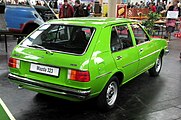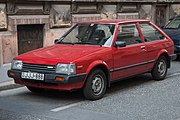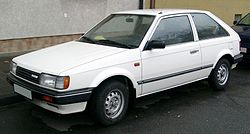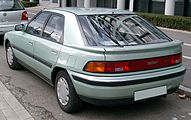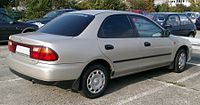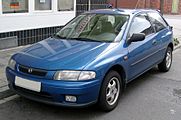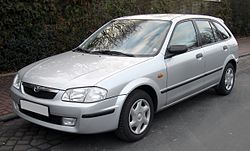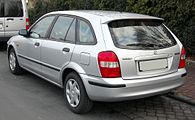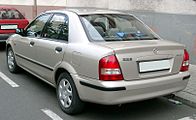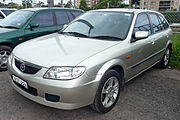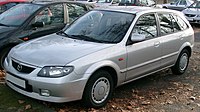Mazda 323
| Mazda 323 | |
|---|---|
| Production period: | 1977-2003 |
| Class : | Compact class |
| Body versions : | Sedan , hatchback , station wagon |
| Previous model: | Mazda 1000/1200/1300 |
| Successor: | Mazda3 |
The Mazda 323 was a compact vehicle from Mazda and was produced in six generations from early 1977 to autumn 2003. In Japan the model was called Mazda Familia and in North America it was initially called Mazda GLC .
From 2002 Mazda changed the numbers in the model range. The successor to the 323 came on the market at the end of October 2003. It was now called Mazda3 .
323 (FA4, 1977-1980)
| 1st generation | |
|---|---|
|
Mazda 323 Hatchback (1977-1979) |
|
| Production period: | 1977-1980 |
| Body versions : | Station wagon , station wagon |
| Engines: |
Otto engines : 1.0–1.4 liters (34–52 kW) |
| Length: | 3820 mm |
| Width: | 1595 mm |
| Height: | 1375 mm |
| Wheelbase : | 2365 mm |
| Empty weight : | 812 kg |
In January 1977 the first generation of the 323 (internal designation: FA4 ) was presented by Mazda. The model series replaced the Mazda 1000/1300 , which had been built over ten years . In contrast to its predecessor, the 323 had a hatchback body. It initially came onto the market with three or five doors. In September 1977 the three- or five-door station wagon 323 Variabel followed .
On offer were four-cylinder engines from 1.0 to 1.4 liters displacement with (in Japan ) 33 to 60.5 kW (45 to 82 hp), which transferred their power to the rear wheels.
In Germany , the introduction took place in February 1977 at prices from 8,490 DM (323/1000) to 11,390 DM (323/1300 Kombi). The sports model SP was delivered exclusively with three doors and a 1.4-liter engine with 51.5 kW / 70 hp in Europe. It can be recognized by its yellow and red rally stripes, matt black bumpers and brightly checked seat fabrics.
As part of a facelift , the 323 received rectangular H4 headlights and larger taillights in the summer of 1979 . The partial leather seats (artificial leather) with their check pattern and integrated headrests are being replaced by velor seats with adjustable headrests.
In Japan the model was called Familia , in the USA the 323 was sold as GLC . This abbreviation stands for "Great Little Car".
| Mazda 323: | 1000 | 1300 | 1400 SP |
|---|---|---|---|
| Engine: | 4-cylinder in-line engine (four-stroke), front | ||
| Displacement: | 985 cc | 1272 cc | 1416 cc |
| Bore × stroke: | 70 mm × 64 mm | 73 mm × 76 mm | 77 mm × 76 mm |
| Performance at 1 / min: | 33 kW (45 PS) at 5500 |
44 kW (60 hp) at 5500 |
51.5 kW (70 hp) at 5700 |
| Max. Torque at 1 / min: | 70 Nm at 3000 | 93 Nm at 3500 | 112 Nm at 3200 |
| Compression: | 8.8: 1 | 9.2: 1 | 9.0: 1 |
| Mixture preparation: | 1 downdraft register carburetor | ||
| Valve control: | hanging valves (overhead camshaft, chain), light alloy cylinder head | ||
| Cooling: | Water cooling | ||
| Transmission: | 4- or 5-speed gearbox aW three-stage automatic rear-wheel drive |
||
| Front suspension: | Strut axle, lower wishbones, coil springs, stabilizer | ||
| Rear suspension: | Rigid axle, double longitudinal control arm, Panhard rod , coil springs | ||
| Body: | Sheet steel, self-supporting | ||
| Track width front / rear: | 1295/1310 mm | ||
| Wheelbase: | 2315 mm | ||
| Dimensions: | Sedan: 3820 mm × 1595 mm × 1375 mm Kombi: 4010 mm × 1595 mm × 1425 mm |
||
| Empty weight: | 810-860 kg | 815-860 kg | 820 kg |
| Maximum speed (factory): | 125 km / h | 140 km / h | 146 km / h |
| 0-100 km / h: | n / A | ||
| Consumption (liters / 100 km): | approx. 8-10 | approx. 8-12 | approx. 8-13 |
| Price: | DM 9,140 (02/79) | from DM 9,990 (02/79) | 10,990 DM (02/79) |
323 (BD, 1980-1985)
| 2nd generation | |
|---|---|
|
Mazda 323 hatchback (1980–1983) |
|
| Production period: | 1980-1985 |
| Body versions : | Sedan , hatchback , station wagon |
| Engines: |
Petrol engines : 1.1–1.5 liters (37–65 kW) |
| Length: | 3955-4155 mm |
| Width: | 1630 mm |
| Height: | 1375 mm |
| Wheelbase : | 2365 mm |
| Empty weight : | 780-855 kg |
A brand new 323 was available from dealers from November 1980 (type code BD). The notchback sedan followed in October 1981. The Kombi 323 Variabel was initially continued in its old form (FA4V). The second 323 was also called Familia in Japan and GLC in America.
The second generation (internal designation: BD ) was more angular, smoother and more modern than its predecessor. For the first time, the front wheels were driven.
The second 323 was available as a hatchback with three or five doors and a notchback with four doors. In Germany, engines from 1.1 liters with 40 kW to 1.5 liters with 65 kW were used. It also became the best-selling Japanese-made car there. This Mazda was also delivered to the GDR in a number of 10,000 vehicles , where it was one of the few "West Cars" that were not available through Genex , but directly against GDR Marks . For reasons of the workshop network, the sale took place mainly to the residents of East Berlin.
In January 1983 the 323 underwent a facelift. The front turn signals went into the bumper , the taillights were redesigned. At the end of 1983 the prototype of a Familia Cabriolet was presented.
Production of the second 323 generation ended in June 1985.
323 (BF, 1985-1989)
| 3rd generation | |
|---|---|
|
Mazda 323 three-door (1985–1987) |
|
| Production period: | 1985-1989 |
| Body versions : | Sedan , hatchback , station wagon |
| Engines: |
Otto engines : 1.1–1.6 liters (40–110 kW) Diesel engines : 1.7 liters (40–42 kW) |
| Length: | 3990-4220 mm |
| Width: | 1645 mm |
| Height: | 1390-1410 mm |
| Wheelbase : | 2400 mm |
| Empty weight : | 810-1000 kg |
The 323 (type code BF) was introduced in July 1985. This continued the basic design, but turned out to be less angular, received a flatter line and narrower headlights. This model was also available with three, four and five doors. The notchback version of the GLX and the 1.5-liter engine with 55 kW (75 hp) cost around 15,900 DM in the Federal Republic of 1985; metallic paint was available for an extra charge of 210 DM. The rear window wiper installed on the notchback until the revision in the summer of 1987 was unusual.
In May 1986 the new 323 Kombi (type BW) based on the current 323 was introduced. In addition, a diesel engine with a displacement of 1.7 liters and 40 kW (54 hp) was now available.
In early 1987, Mazda entered rallying with the 323 and launched a three-door model with all-wheel drive . A 110 kW (150 hp) 1.6-liter turbo engine with two overhead camshafts and injection was used as the engine.
In August 1987 the 323 received a facelift. At the same time, all gasoline engines received an injection and a regulated catalytic converter . The output of the 1.6-liter turbo engine was reduced to 103 kW (140 hp); it was now also available in a front-wheel drive model.
In South Africa, this 323 generation continued to be built into the 1990s as the entry-level Sting and Ford Laser . It was also available there as a Pickup Rustler , which was also sold as a Ford Bantam (the first Bantam / Rustler generation, however, was based on the first Ford Escort with front-wheel drive).
323 (BG, 1989-1994)
| 4th generation | |
|---|---|
|
Mazda 323 hatchback (1989-1994) |
|
| Production period: | 1989-1994 |
| Body versions : | Sedan , hatchback , station wagon |
| Engines: |
Petrol engines : 1.3-1.8 liters (49-136 kW) Diesel engine : 1.7 liters (41 kW) |
| Length: | 3995 mm |
| Width: | 1675 mm |
| Height: | 1380 mm |
| Wheelbase : | 2450 mm |
| Empty weight : | 980-1175 kg |
In September 1989, the fourth generation of the 323 appeared (internal designation: BG ). The design has been consistently developed without losing the reference to its predecessor. One innovation was the five-door coupé-like variant 323F with the abbreviation “F” . This was given a particularly sporty look with its flat line and the pop-up headlights . At the same time, the 323 station wagon was given a facelift and its appearance was adapted to the new series. It was also available with all-wheel drive .
This 323 also featured an all-wheel drive version of the three-door model. This was equipped with a 76 kW (103 hp) 1.8-liter 16V SOHC engine. In Japan the vehicle was also offered as the Eunos 100 (but without all-wheel drive) .
The following motors are available:
- 1.3 l 8V SOHC , gasoline engine with 49 kW (67 PS) 1989–1991
- 1.3 l 16V SOHC, gasoline engine with 54 kW (73 PS) 1989–1994
- 1.6 l 8V SOHC, gasoline engine with 62 kW (84 PS), 1989–1991
- 1.6 l 16V SOHC, gasoline engine with 65 kW (88 PS), 1991–1994
- 1.8 l 16V SOHC, gasoline engine with 76 kW (103 PS)
- 1.8 l 16V DOHC , petrol engine with 94 kW (128 PS), only available in the three- and five-door version "GT"
- 1.7 l diesel 41 kW (55 PS)
BG-8 series (all-wheel drive)
- 1.8 l SOHC, gasoline engine with 76 kW (103 PS) with manual center differential lock
- 1.8 l DOHC, turbo gasoline engine with 120 kW (163 hp) with center and rear axle differential lock
- 1.8 l DOHC, turbo gasoline engine with 136 kW (185 PS), the improved version of the 163 PS model with:
- reinforced engine (forged pistons with integrated piston crown and ring cooling, high-strength connecting rods)
- more heat-resistant outlet valves (with sodium filling)
- larger brakes (including ABS)
- larger turbocharger (ball bearing)
- larger intercooler and, necessary for its covering, wide front bumper / front apron combination
- improved chassis (harder dampers, modified stabilizers)
The all-wheel drive BG-8 with 163 hp 1.8 l turbo engine (sold in Germany as the more expensive TXL 4WD and cheaper TXS 4WD) was built from 1989 to 1992, the 185 hp GT-R was produced in 1993 as a homologation model . In Japan the GT-R even had 210 hp, with full leather upholstery and automatic air conditioning available as options.
323 (BA, 1994-2000)
| 5th generation | |
|---|---|
|
Mazda 323F (1994-1998) |
|
| Production period: | 1994-2000 |
| Body versions : | Limousine , station wagon |
| Engines: |
Otto engines : 1.3–2.0 liters (54–106 kW) Diesel engine : 1.7 liters (60 kW) |
| Length: | 4240 mm |
| Width: | 1695 mm |
| Height: | 1355 mm |
| Wheelbase : | 2600 mm |
| Empty weight : | 1060-1210 kg |
The fifth edition came on the market in September 1994 as a series with the internal designation "BA". All body variants were given an abbreviation after the number (323C: Coupé, 323S: notchback, 323F: hatchback).
The design of the 323F and 323C was kept very sporty, but in contrast to the predecessors it was very round, with almost no edges. For the first time there were driver and front passenger airbags for the 323.
With the start of sales, the 323 station wagon, which had been on the market for eight years, will be discontinued in Germany.
At the beginning there are four gasoline engines to choose from:
- the 1.3-l four-cylinder SOHC with 16 valves and 54 kW (73 hp) (only in the 323S and 323C), which is almost unchanged from the predecessor
- a newly developed 1.5-l four-cylinder DOHC 16V engine with 65 kW (88 PS) (in all models)
- a slightly modified 1.9-liter four-cylinder DOHC of the predecessor with now 84 kW (114 hp) (in all models; except 323P)
- only for the 323F there was a 2.0-l six-cylinder 24V engine with 106 kW (144 hp), followed in 1995 by a 1.7-l turbodiesel with 60 kW (82 hp) for the 323S.
In January 1997 the series was revised. Due to the poor sales of the 323C, Mazda introduced a new three-door model called the 323P. Changes affected the entire interior and some of the technology. Outwardly, only the 323S changed, which now shares the same face with the 323P. The 323C was only available with the 1.5 liter engine, the 323S and 323P with 1.3 and 1.5 liter. The 1.7-liter TD engine will be withdrawn from the range and briefly replaced by a 2.0-liter diesel with 52 kW (71 hp) in the 323S and 323P.
In 1998 Mazda launched two special models of the 323F with leather upholstery and the 1.5 liter engine:
- Edition Elegant with special paintwork in Borneo Green, metallic and beige leather interior
- Edition Sportiv in silver with black leather
In the late summer of 1998, the production and sale of the BA models 323C, 323S and 323F ceased. The 323P was built in parallel to the successor model until 2000.
In Japan, the 323C and 323S models were sold like the previous series under the name Familia (factory code BH). The 323F was marketed as a separate series (factory code CB) under the name Lantis and is also available as a four-door sedan .
323 (BJ, 1998-2003)
| 6th generation | |
|---|---|
|
Mazda 323F (1998-2000) |
|
| Production period: | 1998-2003 |
| Body versions : | Limousine , station wagon |
| Engines: |
Otto engines : 1.3–2.0 liters (53–96 kW) Diesel engines : 2.0 liters (52–74 kW) |
| Length: | 4215-4435 mm |
| Width: | 1705 mm |
| Height: | 1410 mm |
| Wheelbase : | 2610 mm |
| Empty weight : | 1150-1400 kg |
In September 1998 the last generation of the 323 (type code BJ) appeared on the German market. It was offered as a four-door sedan (323S) and as a five-door hatchback (323F).
The model was available in three equipment variants (Comfort, Exclusive, Sportive) and with five different engines.
In May 2000 Mazda also modified this series as part of a facelift (fundamental changes to the front section, interior with new colors and fabrics). At the same time the sale of the 323P of the previous series was stopped.
In 2002 the Exclusive equipment variant was replaced by the Dynamic variant . This had different taillights as well as partially black front headlights.
In autumn 2003, the era of the Mazda 323 ended after more than 26 years. The vehicle is now called Mazda3 according to the new Mazda nomenclature . The Familia series also came to an end in Japan, where the new model is being sold as the Axela .
Engines
| model | Displacement | Engine code | power | Max. Torque | Specialty | construction time |
|---|---|---|---|---|---|---|
| Petrol engines | ||||||
| 1.3 | 1324 cc | B3 | 53 kW (72 PS) | 108 Nm at 4000 min -1 | 1998-2003 | |
| 1.5 | 1498 cc | ZL | 65 kW (88 PS) | 132 Nm at 4000 min -1 | 1998-2000 | |
| 1.6 | 1598 cc | ZM | 72 kW (98 PS) 70 kW (95 PS) * |
145 Nm at 3700 min -1 | also with automatic transmission * | 2000-2003 |
| 1.9 | 1840 cc | FP | 84 kW (114 hp) | 161 Nm at 4000 min -1 | 323F only | 1998-2000 |
| 2.0 | 1991 cc | FS | 96 kW (130 PS) | 171 Nm at 4500 min -1 | 323F only | 2000-2003 |
| 2.0 1 | 1991 cc | FS | 103 kW (140 PS) | 192 Nm at 4500 min -1 | in the Protegé MP3 | 2001-2003 |
| 2.0 turbo 1 | 1991 cc | 125 kW (170 hp) | 217 Nm at 3500 min -1 | in the Mazdaspeed Protegé | 2003 | |
| Diesel engines | ||||||
| 2.0 D | 1998 cc | RF1G | 52 kW (71 hp) | 128 Nm at 3000 min -1 | in the 323P / S | 1998-1999 |
| 2.0 TD | 1998 cc | RF2 | 66 kW (90 PS) | 220 Nm at 2000 min -1 | in the 323F / S | 1998-2000 |
| 2.0 TD | 1998 cc | RF4 | 74 kW (101 hp) | 230 Nm at 2000 to 2600 min -1 | only in the 323F | 2000-2003 |
Weak points
According to the DAT / VDA list, the models with gasoline engines are not E10 compatible.
Web links
Individual evidence
- ^ Automobil Revue , catalog number 1979.
- ^ Joachim Kuch: Japanese automobiles. Motorbuch Verlag, Stuttgart 1990, ISBN 3-613-01365-7 , pp. 74-81.
- ↑ Small tree. In: Der Spiegel , No. 21 of May 18, 1981.
- ↑ Thomas Fischer: Alternative list. In: auto motor und sport . Issue 25/1983, p. 65.
- ↑ Archived copy ( Memento of the original from May 11, 2011 in the Internet Archive ) Info: The archive link was automatically inserted and not yet checked. Please check the original and archive link according to the instructions and then remove this notice.

